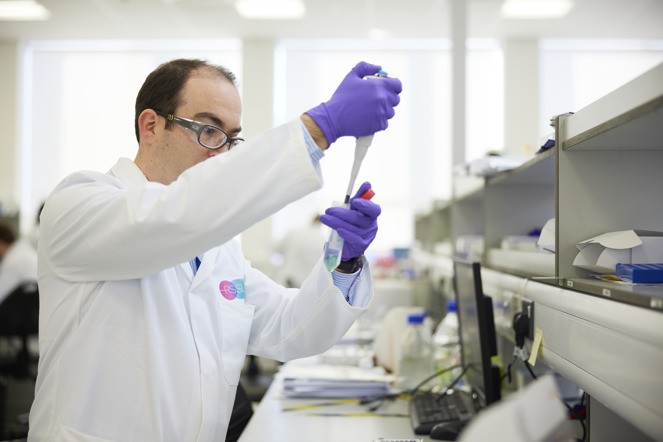PCR is a DNA technique, which targets a specific sequence of DNA unique to the food containing the allergen. PCR tests tend to be qualitative. The results obtained cannot easily be converted into protein, and the presence or absence of DNA does not necessarily prove presence or absence of protein. Therefore, PCR is not typically recommended where a suitable ELISA test for allergens is available. Some foods however can cause adverse matrix interferences with ELISA tests and the proteins can be degraded or altered during food processing, which may cause them to be more difficult (or in some cases not possible) to detect with ELISA. In these cases, a PCR test may be more suitable.
There are other techniques that can be used, for example LC-MS/MS (Liquid Chromatography Tandem Mass Spectrometry) which digests proteins into peptides to detect. This technique is a highly sensitive, quantitative analysis; however, it is hard to translate the result into allergen protein. Currently there are no standardised allergen methods for this technique, which can lead to variability of results. There is also a high cost associated with the analysis. Therefore, at this time LC-MS/MS is typically only used when ELISA or PCR is not suitable due to complex matrixes or highly processed contaminants. Sulphites cannot be detected using the above methods and instead requires a distillation or titration method to isolate and capture the sulphur dioxide. The selected sulphite method will depend on the sample type and can be used for food samples and rinse waters.
Recommended additional validation
Foods are complex matrices and biological tests can be prone to matrix interferences, causing adverse reactions in the testing and impacting the validity of the test. Hence, it is important to collect evidence that the right test has been chosen for you and avoid potential false positive or false negative results. This can be done through performing extra competencies like spike recovery tests, cross-reactivity checks and analysing positive controls (explained in more detail below).
A false positive result occurs where the test detects the allergen and reports a detected result, when no allergen was present in the sample. This could be a risk to your business and result in an unnecessary recall or investigation.
A false negative result occurs where the test could not detect the allergen and reports a not detected result, despite an allergen being present in the sample. This could be a risk to both the consumer and the business as product will be released and an allergic consumer could have a reaction, potentially leading to a public recall.
Spike recovery checks are an important part of mitigating against potential false results, as they provide evidence that the test you have chosen is suitable for your sample type. A spike recovery check involves adding a known quantity of the allergen to an aliquot of your sample, analysing it, and then comparing the result obtained against the known quantity of allergen added. The laboratory can determine if the result is within the expected range and whether the ingredients are adversely reacting to the test, based on the percentage of allergen the analysis was able to recover.
Cross-reactivity occurs when the test mistakenly detects something as the allergen it was looking for. Usually cross-reactivity is caused by something that is biologically similar to the allergen, e.g. a similar shaped protein or sequence of DNA. For example, all mustard ELISA kits cross-react with rapeseed and other seeds from the Brassica genus, and walnut PCR tests often cross-react with pecan. When there is a detected result that is unexpected from the analysis, cross-reactivity checks can be completed by the laboratory to rule out a potential false positive result.
Positive control testing can be a useful tool if you know your contaminant. This is where a product or ingredient that contains the allergen of concern is sent in for testing to prove that the test can detect the allergen when it is supposed to be there. If the test cannot detect the protein when it is supposed to be there as a deliberate ingredient, for example due to processing or interference, then the test will not detect the protein when it is there unintentionally in small quantities.
Factory based allergen protein techniques
Factory based tests, like RLFD (Rapid Lateral Flow Devices), can be useful as a verification tool as they are quick and easy to use. They are typically designed for rinse waters and environmental swabs, as the extraction procedures are not exhaustive and often quite rudimentary, and a complex matrix like food can easily cause interferences. It is important when using RLFDs that they are validated, as the advertised detection limits can vary depending on the source of contaminant. For example, the detection limit for a milk RLFD may be based on liquid milk but the detection limit may be different if the contaminant is different, e.g., cheese or whey.
Partnering with the right food allergen testing laboratory
There are many challenges when it comes to food allergen testing and it is important to pick the right testing method based on your sample matrix and contaminant. Therefore, it is important that you choose a laboratory that can help you understand, navigate, and mitigate these challenges.
When looking for a laboratory, consider whether they are independently accredited against BS EN ISO/IEC 17025, not just for their laboratory but ideally for the specific test method as well. Will they perform extra validations, such as spike recovery testing and cross-reactivity checks? Consider how good their communication is with you, are they able to help you choose the appropriate test for your sample and can they help you understand and interpret the results? You will want them to have good experience and expertise in food allergen testing as well as a good understanding and up-to-date knowledge of the food industry.
